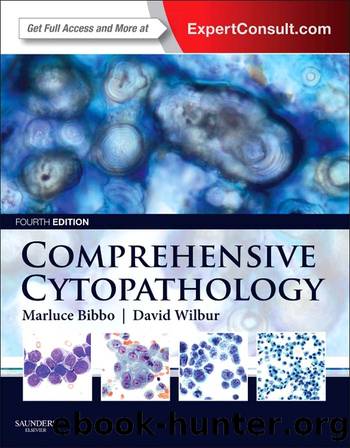Comprehensive Cytopathology: Expert Consult: Online by Marluce Bibbo & David Wilbur

Author:Marluce Bibbo & David Wilbur [Bibbo, Marluce]
Language: eng
Format: azw3
ISBN: 9780323265768
Publisher: Elsevier Health Sciences
Published: 2014-09-04T16:00:00+00:00
21
Imaging Techniques
Christopher R.B. Merritt
Contents
Introduction
Imaging Methods
Conventional Radiography and Fluoroscopy
Computed Tomography
Magnetic Resonance
Ultrasound
Positron Emission Tomography/Image Fusion
Complications of Image-guided FNAB
Image-guided FNAB of Specific Organs
Thyroid, Peripheral Lymph Nodes, Salivary Gland, and Superficial Soft Tissue Masses
Breast
Lungs and Pleura
Mediastinum
Abdominal and Pelvic Organs
Concluding Remarks
Introduction
Although modern imaging and laboratory methods permit precise identification of the presence and location of disease throughout the body, cytologic or histologic examination of tissue remains an essential step in establishing a definitive diagnosis and in planning patient management. Tissue sampling by excision or biopsy, coupled with modern methods of tissue processing and examination for specific immunohistochemical markers, plays an important role in the differentiation of benign and malignant disease, and in optimizing therapy for malignancy. The widespread availability of modern imaging equipment has given rise to the adoption of minimally invasive diagnosis of pathology, using the combined skills of the imager, interventionalist, and cytopathologist. Image-guided fine-needle aspiration biopsy (FNAB) can be quickly accomplished with minimal risk and discomfort, avoiding more invasive, risky, and costly procedures for definitive diagnosis.
Image-guided FNAB ideally involves the active participation of a cytopathologist to evaluate the adequacy of specimens as they are obtained. This assures that sufficient cells for diagnosis are obtained with the minimum number of samples, reducing patient risk and discomfort and the inconvenience and anxiety of returning for additional samples if the initial attempts are unsuccessful.
Indications for image-guided percutaneous needle biopsy include, but are not limited to, the following:
1. To establish the benign or malignant nature of a lesion
2. To obtain material for microbiologic analysis in patients with known or suspected infections
3. To stage patients with known or suspected malignancy when local spread or distant metastasis is suspected
4. To determine the nature and extent of certain diffuse parenchymal diseases.
Download
This site does not store any files on its server. We only index and link to content provided by other sites. Please contact the content providers to delete copyright contents if any and email us, we'll remove relevant links or contents immediately.
Periodization Training for Sports by Tudor Bompa(8170)
Why We Sleep: Unlocking the Power of Sleep and Dreams by Matthew Walker(6618)
Paper Towns by Green John(5091)
The Immortal Life of Henrietta Lacks by Rebecca Skloot(4525)
The Sports Rules Book by Human Kinetics(4294)
Dynamic Alignment Through Imagery by Eric Franklin(4118)
ACSM's Complete Guide to Fitness & Health by ACSM(3989)
Kaplan MCAT Organic Chemistry Review: Created for MCAT 2015 (Kaplan Test Prep) by Kaplan(3940)
Introduction to Kinesiology by Shirl J. Hoffman(3726)
Livewired by David Eagleman(3684)
The Death of the Heart by Elizabeth Bowen(3552)
The River of Consciousness by Oliver Sacks(3541)
Alchemy and Alchemists by C. J. S. Thompson(3451)
Bad Pharma by Ben Goldacre(3357)
Descartes' Error by Antonio Damasio(3230)
The Emperor of All Maladies: A Biography of Cancer by Siddhartha Mukherjee(3066)
The Gene: An Intimate History by Siddhartha Mukherjee(3047)
The Fate of Rome: Climate, Disease, and the End of an Empire (The Princeton History of the Ancient World) by Kyle Harper(3003)
Kaplan MCAT Behavioral Sciences Review: Created for MCAT 2015 (Kaplan Test Prep) by Kaplan(2940)
